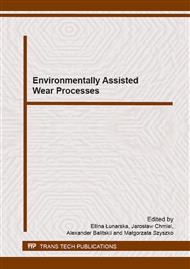[1]
R.Z. Valiev, R.K. Islamgaliev, and I.V. Aleksandrov, Bulk nanostructured materials from severe plastic deformation, Progress Mat. Sci. 45 (103), (2000).
DOI: 10.1016/s0079-6425(99)00007-9
Google Scholar
[2]
K.J. Kurzydlowski. Physical, chemical, and mechanical properties of nanostructured materials. Material Science, Vol. 42 (1), (2006) 85 - 94.
Google Scholar
[3]
O.V. Maksymiv, H.M. Nykyforchyn, Effect of hydrogen on mechanical behaviour of surface nanocrystalline steel structure / E-MRS 2011 Fall Meeting - Symposium C: Mechanical properties of nanomaterials - experiments and modeling (CD), Warsaw University of Technology, (2011).
Google Scholar
[4]
H.M. Nykyforchyn, V.I. Kyryliv, Dz.V. Slobodjan and Ju.M. Koval, Structural steels surface modification by mechanical pulse treatment for corrosion protection and wear resistance, Surface and Coatings Technology 100-101 (1998) 125-127.
DOI: 10.1016/s0257-8972(97)00600-2
Google Scholar
[5]
H. Nykyforchyn, E. Lunarska, O. Kyryliv, A. Bassarab, Umocnenie powierzchniowe stopow tytanu poprzez mechanicno-impulsowa obrobke. VIII ogolnopolska konferencja «Tytan I jego stopy», Warsawa-Serock, (2005) 253-257 (in Polish).
Google Scholar
[6]
V.I. Kyryliv, Improvement of the wear resistance of medium-carbon steel by nanodispersion of surface layers. Material Science, Vol. 48(1), 2012, p.119.
DOI: 10.1007/s11003-012-9481-2
Google Scholar
[7]
L. G. Akselrud, Yu. M. Gryn', P. Yu. Zavaliy at al., Use of the CSD program package for structure determination from data / Abstr. of the European Powder Diffraction Conf., Enshede, Netherlands, 1992. – Material Science. 41, (1993) 133–140.
Google Scholar
[8]
Powder Diffraction File 1973: Search manual alphabetical listing and search section of frequently encountered phases. – Inorganic- Philadelphia, (1974).
Google Scholar
[9]
V. I. Kyryliv, T.M. Kalichak, Yu. I. Babey, Equipment for hardening of the external cylindrical surface of components, Authors Certificate of the USSR, MK14 I24I 29/04, Bull. No. 47. (1985). (in Russian).
Google Scholar
[10]
T.N. Kalychak, V.I. Kyryliv, A.I. Soshko, et. al., Method for Hardening of Surfaces of Articles, Authors Certificate of the USSR, MK15 S2D 5/00, S23S 8/00, Bull. No. 23. (1991). (in Russian).
Google Scholar
[11]
V.I. Kyryliv, Surface saturation of steels with carbon during mechanical – pulse treatment. Material Science, Vol. 35(6), May, (2000), 853-856.
DOI: 10.1007/bf02359467
Google Scholar
[12]
D. H. Buckley, Surface effects in adhesion, Friction, Wear and Lubrication, Elsevier (1981).
Google Scholar


